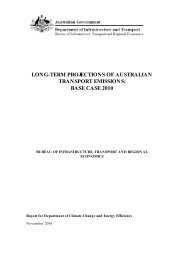Implications of Climate Change for Australia's World Heritage ...
Implications of Climate Change for Australia's World Heritage ...
Implications of Climate Change for Australia's World Heritage ...
You also want an ePaper? Increase the reach of your titles
YUMPU automatically turns print PDFs into web optimized ePapers that Google loves.
IMPLICATIONS OF CLIMATE CHANGE FOR AUSTRALIA’S WORLD HERITAGE PROPERTIES: A PRELIMINARY ASSESSMENT<br />
Rainfall<br />
<strong>Change</strong>s in rainfall and a rise in the basal altitude <strong>of</strong> the orographic cloud layer are likely to have a significant impact on the<br />
natural values <strong>of</strong> Australia’s <strong>World</strong> <strong>Heritage</strong> properties. Most <strong>of</strong> Australia’s <strong>World</strong> <strong>Heritage</strong> properties have experienced a<br />
decline in rainfall over the past 35 years. Current CSIRO projections indicate that mean annual rainfall will continue to fall in<br />
many regions across Australia. If annual rainfall remains unchanged, evaporation is likely to be higher (CSIRO 2006), resulting<br />
in drier conditions.<br />
A potential rise in the average basal altitude <strong>of</strong> the orographic cloud layer due to global warming (Pounds et al. 1999) is<br />
an issue <strong>of</strong> concern <strong>for</strong> a range <strong>of</strong> values across a number <strong>of</strong> <strong>World</strong> <strong>Heritage</strong> properties, in particular in the Wet Tropics <strong>of</strong><br />
Queensland and the Lord Howe Island Group. The orographic cloud layer envelops the mountain summits <strong>of</strong> these <strong>World</strong><br />
<strong>Heritage</strong> properties, and provides an essential source <strong>of</strong> water <strong>for</strong> many high-altitude plants and animals by a process known<br />
as ‘cloud stripping’ by high-altitude rain<strong>for</strong>ests. Very little is known about the hydrology <strong>of</strong> cloud stripping and the resulting<br />
precipitation derived from this process. However, it is fairly certain that a rise in basal altitude <strong>of</strong> the orographic cloud layer<br />
would exacerbate the effects <strong>of</strong> long-term drought (Still et al. 1999), resulting in serious consequences <strong>for</strong> many plant and<br />
animal species. Microhylid frogs 9 , <strong>for</strong> example, rely on cloud mist <strong>for</strong> their long-term survival. The disappearance <strong>of</strong> about 20<br />
frog species in the highland <strong>for</strong>ests <strong>of</strong> Monteverde, Costa Rica, was probably due to changes in the extent <strong>of</strong> mountain mist<br />
following an increase in surface temperature (Pounds et al. 1999).<br />
Tropical cyclones and extreme weather events<br />
Research has shown that there has been an increase in the destructiveness <strong>of</strong> cyclones since the 1970s, which correlates<br />
with the observed increase in sea surface temperature (Emanuel 2005). Tropical cyclones are common in Kakadu National<br />
Park, the Great Barrier Reef and in the Wet Tropics <strong>of</strong> Queensland. Current projections indicate that cyclones are expected<br />
to be less common but more intense (CSIRO 2006), which may inflict greater physical damage to vegetation including the<br />
uprooting <strong>of</strong> trees by destructive winds. High-intensity cyclones may inflict greater damage on certain vegetation types than<br />
on others. Eucalyptus trees taller than 9 m are particularly prone to wind damage (Williams & Douglas 1995). The uprooting<br />
<strong>of</strong> trees can also lead to increased erosion during periods <strong>of</strong> intense rainfall. Invasive species such as climbing vines can also<br />
be favoured in the aftermath <strong>of</strong> tropical cyclones.<br />
Increased sea surface temperatures, changes in ocean circulation and ocean acidification<br />
The impacts <strong>of</strong> rising sea surface temperatures and ocean acidification will most likely have catastrophic consequences <strong>for</strong><br />
marine organisms such as coral and the species dependent on these keystone species, as well as <strong>for</strong> calcifying organisms<br />
such as plankton, sea urchins and coral reef systems (Feely et al. 2004). Acidification takes place via the reaction <strong>of</strong> dissolved<br />
carbon dioxide with water to produce carbonic acid which, in turn, increases acidity. The resulting acidification could prevent<br />
calcifying organisms—such as corals, shellfish and some species <strong>of</strong> phytoplankton—from producing calcium carbonate and<br />
thus prevent shell <strong>for</strong>mation. Coral communities around the Lord Howe Island Group (which are the southernmost true coral<br />
reefs in the world) and the Great Barrier Reef are likely to be affected if the oceans become more acidic. To date, there have<br />
been no experimental studies examining the sensitivity <strong>of</strong> cold-water coral reef systems, such as those in the Lord Howe<br />
Island Group, to CO -induced ocean acidification. However, it is expected that the acidification will affect the recruitment <strong>of</strong><br />
2<br />
cold corals more than their warm-water counterparts because the carbonate saturation state is generally lower at higher<br />
latitudes than at lower latitudes (i.e. Great Barrier Reef) (The Royal Society 2005).<br />
9 Microhylid frogs lay their eggs on the <strong>for</strong>est litter and there<strong>for</strong>e require a constant source <strong>of</strong> moisture from the cloud stripping process to prevent<br />
desiccation <strong>of</strong> eggs and larvae.<br />
23






